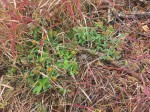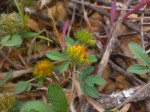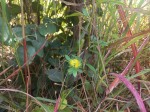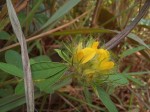Crotalaria ononoides
Selected images: Click on each image to see a larger version and details of the record View all images (6)
Detailed records: Display species records QDS maps by: Google Maps Point records by Google Maps
Species details: Click on each item to see an explanation of that item (Note: opens a new window)
| Synonyms: | |
| Common names: | |
| Frequency: | |
| Status: | |
| Description: |
Much branched spreading annual, procumbent or ascending, sometimes up to 0.5–1 m tall; branches pilose with subappressed or spreading hairs. Leaves shortly petiolate, 3-foliolate; leaflets mostly 2.5–5(6) × 0.8–1.8(2.4) cm, lanceolate to elliptic or obovate, the upper ones often longer and proportionally narrower, glabrous to sparsely pilose above, subappressed pilose beneath; stipules simple or 2–3(5)-fid, up to 5–13 mm long, with both the simple stipules and segments linear-subulate. Flowers numerous in sessile heads; bracts basally fused to the pedicel, spreading from just below the calyx, 3-fid with linear segments up to 10–13 mm long; bracteoles basally fused to the calyx tube, the free part directed forwards, 8–12 mm long, linear. Calyx 7–10(12) mm long, deeply divided, slightly 2-lipped, pilose; lobes subulate, caudate, 4–5 times as long as the tube. Standard elliptic-obovate to subcircular, yellow, finely veined or reddish flushed with age, glabrous except along the midvein outside; wings ± as long as the keel; keel 7–9 mm long, subangular, narrowly beaked. Pod sessile, 8–12 mm long, ellipsoid, glabrous except for a few hairs at the apex, 8–14-seeded. Seeds 1.5–2 mm long, oblique-cordiform, smooth, pale orange-brown. |
| Type location: |
Sierra Leone |
| Notes: | |
| Derivation of specific name: | ononoides : Ononis-like, referring to the genus Ononis |
| Habitat: | |
| Altitude range: (metres) | |
| Flowering time: | Feb - May |
| Worldwide distribution: | Widespread from West to East and south Central Africa |
| Growth form(s): | Annual. |
| Endemic status: | |
| Red data list status: | |
| Insects associated with this species: | |
| Spot characters: | Display spot characters for this species |
| Literature: |
Martins, E.S. et al. (2003). Papilionoideae Flora Zambesiaca 3(7) Pages 130 - 131. (Includes a picture). Ntore, S. & al. (2024). Checklist of the vascular plants of Burundi Page 119. |
Other sources of information about Crotalaria ononoides:
Our websites:
Flora of Zambia: Crotalaria ononoidesExternal websites:
African Plants: A Photo Guide (Senckenberg): Crotalaria ononoidesAfrican Plant Database: Crotalaria ononoides
BHL (Biodiversity Heritage Library): Crotalaria ononoides
EOL (Encyclopedia of Life): Crotalaria ononoides
GBIF (Global Biodiversity Information Facility): Crotalaria ononoides
Google: Web - Images - Scholar
iNaturalist: Crotalaria ononoides
IPNI (International Plant Names Index): Crotalaria ononoides
JSTOR Plant Science: Crotalaria ononoides
Mansfeld World Database of Agricultural and Horticultural Crops: Crotalaria ononoides
Plants of the World Online: Crotalaria ononoides
Tropicos: Crotalaria ononoides
Wikipedia: Crotalaria ononoides





